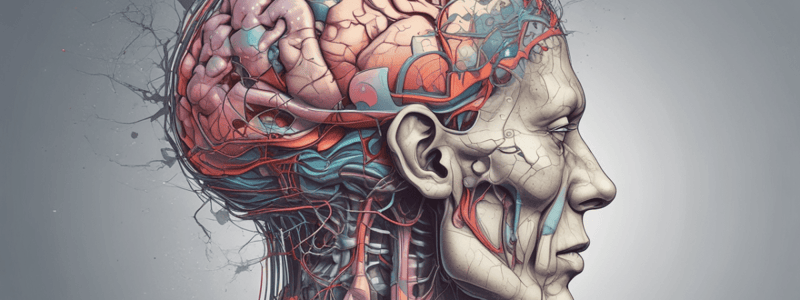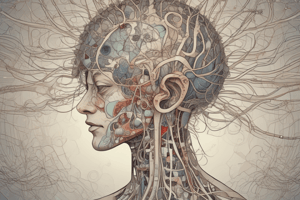Podcast
Questions and Answers
What is a warning sign for a headache?
What is a warning sign for a headache?
- A headache that improves with over-the-counter pain medication
- A headache that occurs at the same time every day
- New onset of headache in a patient with a history of migraines
- A headache that worsens with change in position (correct)
What is a key indicator of a possible neurological process in a patient's facial muscles?
What is a key indicator of a possible neurological process in a patient's facial muscles?
- Facial edema
- Symmetry in facial muscles
- Pain or pressure in the sinuses
- Asymmetry in facial muscles (correct)
What is a possible cause of facial pain?
What is a possible cause of facial pain?
- Papilledema
- Trigeminal neuralgia (correct)
- HIV
- Temporal arteritis (correct)
What is a symptom of vertebral basilar TIA?
What is a symptom of vertebral basilar TIA?
What is a warning sign for a life-threatening presentation of a headache?
What is a warning sign for a life-threatening presentation of a headache?
What is a potential concern in a patient presenting with facial pain and sinus pressure?
What is a potential concern in a patient presenting with facial pain and sinus pressure?
What is a life-threatening diagnosis that should be ruled out in a patient with vertigo?
What is a life-threatening diagnosis that should be ruled out in a patient with vertigo?
What is a key consideration in a patient with a malignancy presenting with a headache?
What is a key consideration in a patient with a malignancy presenting with a headache?
What is a possible cause of a headache with papilledema?
What is a possible cause of a headache with papilledema?
What is a potential concern in a patient presenting with facial droop?
What is a potential concern in a patient presenting with facial droop?
What is a symptom of preclampsia?
What is a symptom of preclampsia?
What is a key consideration in a patient with HIV presenting with a headache?
What is a key consideration in a patient with HIV presenting with a headache?
During a cardiovascular exam, why is it important to palpate the carotid arteries one at a time?
During a cardiovascular exam, why is it important to palpate the carotid arteries one at a time?
What is the significance of finding a fixed and hard lymph node during palpation?
What is the significance of finding a fixed and hard lymph node during palpation?
Why is it important to have the patient turn their head to the side during the assessment of JVD distention?
Why is it important to have the patient turn their head to the side during the assessment of JVD distention?
What does a deviated trachea indicate?
What does a deviated trachea indicate?
What is the purpose of palpating the thyroid gland?
What is the purpose of palpating the thyroid gland?
Why is it important to record findings during a neck examination?
Why is it important to record findings during a neck examination?
What is the purpose of assessing the strength of the trapezius and sternocleidomastoid muscles?
What is the purpose of assessing the strength of the trapezius and sternocleidomastoid muscles?
What is the primary reason for examining the scalp during a physical examination?
What is the primary reason for examining the scalp during a physical examination?
What is the primary function of cranial nerve seven during a physical examination?
What is the primary function of cranial nerve seven during a physical examination?
What is the most common skin disorder that can cause reddish or silver, scaly patches on the face and head?
What is the most common skin disorder that can cause reddish or silver, scaly patches on the face and head?
What is the primary reason for palpating the temporal mandibular joint during a physical examination?
What is the primary reason for palpating the temporal mandibular joint during a physical examination?
What is the primary concern when palpating the superclavicular lymph nodes during a physical examination?
What is the primary concern when palpating the superclavicular lymph nodes during a physical examination?
What is the primary purpose of assessing the patient's neck during a physical examination?
What is the primary purpose of assessing the patient's neck during a physical examination?
What is the primary concern when evaluating a patient with facial asymmetry?
What is the primary concern when evaluating a patient with facial asymmetry?
A patient presents with a headache and a history of malignancy. What should be suspected?
A patient presents with a headache and a history of malignancy. What should be suspected?
What is a key indicator of a possible infectious process in a patient with facial edema?
What is a key indicator of a possible infectious process in a patient with facial edema?
Which of the following is NOT a characteristic of trigeminal neuralgia?
Which of the following is NOT a characteristic of trigeminal neuralgia?
What is the primary concern when evaluating a patient with a headache and a history of HIV?
What is the primary concern when evaluating a patient with a headache and a history of HIV?
A patient presents with facial pain and sinus pressure. What should be suspected?
A patient presents with facial pain and sinus pressure. What should be suspected?
What is the primary concern in a patient presenting with a headache and papilledema?
What is the primary concern in a patient presenting with a headache and papilledema?
What is the primary concern when evaluating a patient with a new onset headache over age 50?
What is the primary concern when evaluating a patient with a new onset headache over age 50?
A patient presents with a headache, neck stiffness, and fever. What is the most likely diagnosis?
A patient presents with a headache, neck stiffness, and fever. What is the most likely diagnosis?
What is the primary concern in a patient presenting with vertigo and dysarthria?
What is the primary concern in a patient presenting with vertigo and dysarthria?
A patient presents with a headache that is aggravated by a change in position. What is the most likely diagnosis?
A patient presents with a headache that is aggravated by a change in position. What is the most likely diagnosis?
What is the primary concern in a patient presenting with facial pain and tenderness of the adjacent scalp?
What is the primary concern in a patient presenting with facial pain and tenderness of the adjacent scalp?
What is the significance of detecting cranial nerve seven asymmetry during a facial examination?
What is the significance of detecting cranial nerve seven asymmetry during a facial examination?
What is the primary reason for palpating the temporal arteries during a scalp examination?
What is the primary reason for palpating the temporal arteries during a scalp examination?
What is the primary concern when assessing the patient's hair pattern during a scalp examination?
What is the primary concern when assessing the patient's hair pattern during a scalp examination?
What is the significance of detecting scaleness on the scalp during a physical examination?
What is the significance of detecting scaleness on the scalp during a physical examination?
What is the primary purpose of assessing the patient's facial expression and movement during a physical examination?
What is the primary purpose of assessing the patient's facial expression and movement during a physical examination?
What is the primary concern when palpating the superclavicular lymph nodes during a physical examination?
What is the primary concern when palpating the superclavicular lymph nodes during a physical examination?
What is the primary purpose of assessing cervical adenopathy during a physical examination?
What is the primary purpose of assessing cervical adenopathy during a physical examination?
What is the significance of finding a deviated trachea during palpation?
What is the significance of finding a deviated trachea during palpation?
Why is it important to palpate the carotid arteries one at a time during a cardiovascular exam?
Why is it important to palpate the carotid arteries one at a time during a cardiovascular exam?
What is the purpose of assessing the patient's neck mobility during a physical examination?
What is the purpose of assessing the patient's neck mobility during a physical examination?
What is the significance of finding an enlarged and movable lymph node during palpation?
What is the significance of finding an enlarged and movable lymph node during palpation?
What is the purpose of inspecting the thyroid gland during a physical examination?
What is the purpose of inspecting the thyroid gland during a physical examination?
Why is it important to record findings during a neck examination?
Why is it important to record findings during a neck examination?
Flashcards are hidden until you start studying
Study Notes
Facial Muscles and Neurological Process
- Facial muscles: symmetry is important, asymmetry indicates a possible neurological process
- Subjective questions to ask:
- Do you have headaches? Head injuries?
- What is the frequency, severity, and location of the headaches?
- Were there any associated symptoms, such as loss of consciousness, amnesia, or dizziness?
- Is there any surgical history or craniotomy?
- Are there any face pains or changes in appearance?
Headache and Neurological Process
- Warning signs for headaches:
- Progressive worsening
- Sudden onset
- Change in pattern from past headaches
- Over 50 years old
- Presence of malignancy, HIV, or pregnancy
- Positional or precipitated by Valsalva or exertion
- Papilledema or neck stiffness
- Focal deficits
- Possible causes of headaches:
- Bleed or CVA
- Malignancy
- Coagulopathy
- Infectious process
- Syphilis
- Pre-eclampsia
Facial Pain
- Possible causes of facial pain:
- Sinusitis
- Trigeminal neuralgia
- Temporal arteritis
- Characteristics of trigeminal neuralgia:
- Sharp, brief, lightning-like stabs
- Abrupt onset
- Waxing and waning
- More likely to occur during the day
- Can be precipitated by exhaustion
- Can be triggered by touching certain areas of the lower face
- Characteristics of temporal arteritis:
- Chronic inflammation of the cranial arteries
- Associated with polymyalgia
- Located near the involved artery
- May be subjectively reported as aching, throbbing, or burning
- Variable onset, duration, and recurrence
Objective Exam
- Inspection:
- Look for symmetry of facial structures
- Inspect the scalp, hair, face, and cranial nerves
- Look for any areas of hair loss, masses, lesions, or abnormal hair patterns
- Palpation:
- Palpate the skull, scalp, hair, face, and cranial nerves
- Look for any lesions, edema, or tenderness
- Cranial nerves:
- Cranial nerve 7: motor abilities
- Cranial nerve 5: motor and sensory abilities
- Temporal arteries and temporal mandibular joint:
- Palpate for tenderness or eliciting pain
Face and Cranial Nerves
- Look for symmetry in the face
- Inspect for abnormal movements or structures
- Cranial nerve 7:
- Motor abilities
- Ask patient to smile, frown, and puff out their cheeks
- Note any asymmetry or Bell's palsy
- Cranial nerve 5:
- Motor and sensory abilities
- Different ways to test
- Other conditions to consider:
- Acromegaly
- Exophthalmos
- Parkinson's disease
- Cushing's syndrome
- Myxedema
Neck and Thyroid
- Inspection:
- Look for symmetry and normal cephalic or atraumatic findings
- Comment on texture, location, and edema of hair
- Palpation:
- Palpate the lymph nodes, starting from the preauricular and working down to the super-clavicular
- Palpate the trachea and carotid
- Look for any obvious masses, bulges, or pulsations
- Note any deviation of the trachea
- Thyroid:
- Inspect the curvature of the neck and look for any obvious goiter
- Palpate the thyroid, feeling for the rise of the isthmus
- Other conditions to consider:
- Lymphadenopathy
- Malignancy
- Congestive heart failure
- Pneumothorax
Facial Muscles and Neurological Process
- Facial muscles: symmetry is important, asymmetry indicates a possible neurological process
- Subjective questions to ask:
- Do you have headaches? Head injuries?
- What is the frequency, severity, and location of the headaches?
- Were there any associated symptoms, such as loss of consciousness, amnesia, or dizziness?
- Is there any surgical history or craniotomy?
- Are there any face pains or changes in appearance?
Headache and Neurological Process
- Warning signs for headaches:
- Progressive worsening
- Sudden onset
- Change in pattern from past headaches
- Over 50 years old
- Presence of malignancy, HIV, or pregnancy
- Positional or precipitated by Valsalva or exertion
- Papilledema or neck stiffness
- Focal deficits
- Possible causes of headaches:
- Bleed or CVA
- Malignancy
- Coagulopathy
- Infectious process
- Syphilis
- Pre-eclampsia
Facial Pain
- Possible causes of facial pain:
- Sinusitis
- Trigeminal neuralgia
- Temporal arteritis
- Characteristics of trigeminal neuralgia:
- Sharp, brief, lightning-like stabs
- Abrupt onset
- Waxing and waning
- More likely to occur during the day
- Can be precipitated by exhaustion
- Can be triggered by touching certain areas of the lower face
- Characteristics of temporal arteritis:
- Chronic inflammation of the cranial arteries
- Associated with polymyalgia
- Located near the involved artery
- May be subjectively reported as aching, throbbing, or burning
- Variable onset, duration, and recurrence
Objective Exam
- Inspection:
- Look for symmetry of facial structures
- Inspect the scalp, hair, face, and cranial nerves
- Look for any areas of hair loss, masses, lesions, or abnormal hair patterns
- Palpation:
- Palpate the skull, scalp, hair, face, and cranial nerves
- Look for any lesions, edema, or tenderness
- Cranial nerves:
- Cranial nerve 7: motor abilities
- Cranial nerve 5: motor and sensory abilities
- Temporal arteries and temporal mandibular joint:
- Palpate for tenderness or eliciting pain
Face and Cranial Nerves
- Look for symmetry in the face
- Inspect for abnormal movements or structures
- Cranial nerve 7:
- Motor abilities
- Ask patient to smile, frown, and puff out their cheeks
- Note any asymmetry or Bell's palsy
- Cranial nerve 5:
- Motor and sensory abilities
- Different ways to test
- Other conditions to consider:
- Acromegaly
- Exophthalmos
- Parkinson's disease
- Cushing's syndrome
- Myxedema
Neck and Thyroid
- Inspection:
- Look for symmetry and normal cephalic or atraumatic findings
- Comment on texture, location, and edema of hair
- Palpation:
- Palpate the lymph nodes, starting from the preauricular and working down to the super-clavicular
- Palpate the trachea and carotid
- Look for any obvious masses, bulges, or pulsations
- Note any deviation of the trachea
- Thyroid:
- Inspect the curvature of the neck and look for any obvious goiter
- Palpate the thyroid, feeling for the rise of the isthmus
- Other conditions to consider:
- Lymphadenopathy
- Malignancy
- Congestive heart failure
- Pneumothorax
Studying That Suits You
Use AI to generate personalized quizzes and flashcards to suit your learning preferences.




